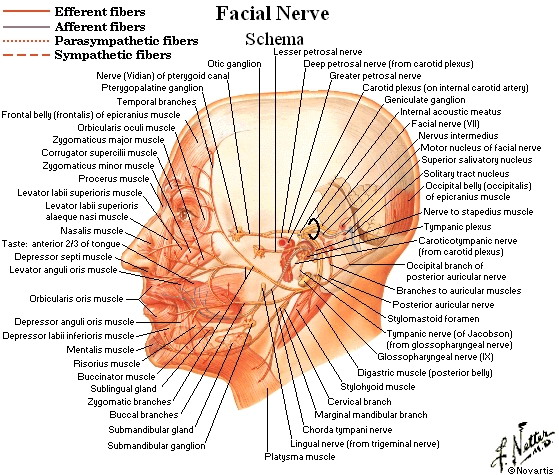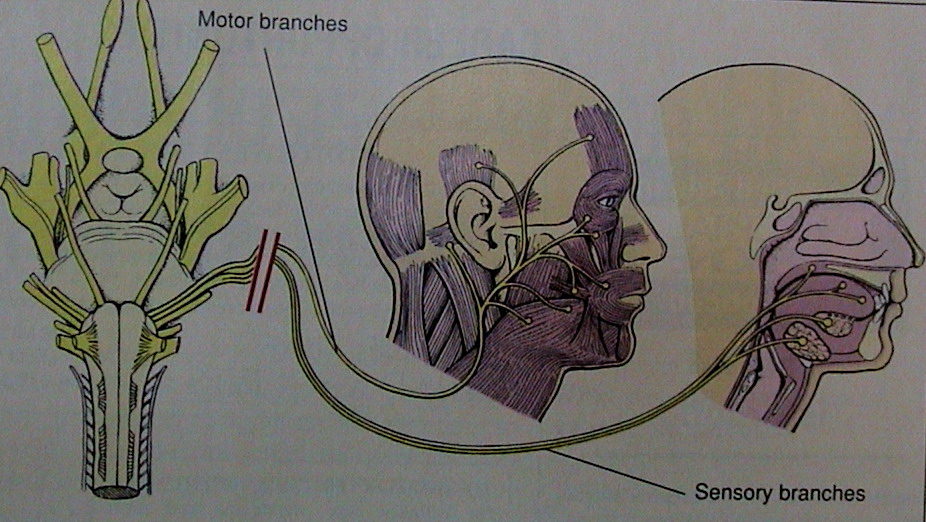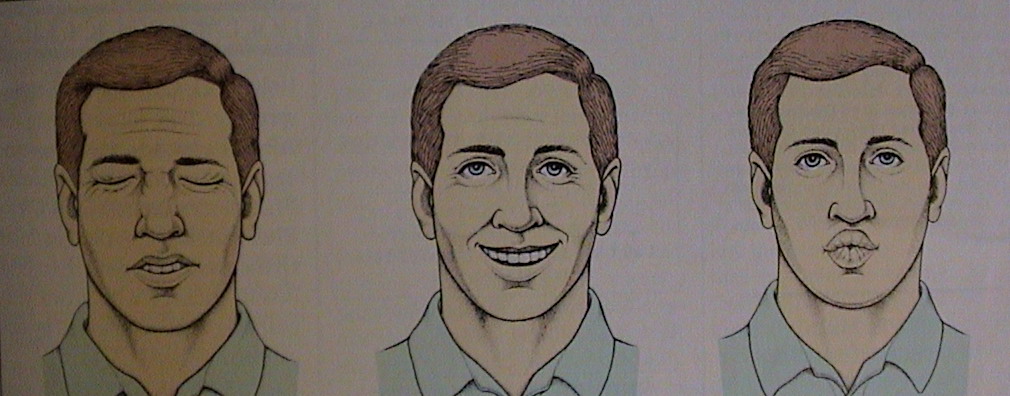
解剖生理
 |
面神經由運動、感覺、副交感等3種神經縴維組成。
 |
(1)運動神經︰運動核位于橋腦下部腹外側,在展神經核外下方,核內的運動細胞分為背側、腹側兩部,分別支配面部上、
下部肌肉。從面神經核發出縴維,先向後近中線繞過展神經核(內膝),再向前下行,于橋腦下緣鄰近听神經處穿出。
穿越蛛網膜下腔,在听神經上方進入內听道,轉入鼓室內側的面神經管下行,于轉彎處(外膝)橫過膝狀神經節,
最後從睫乳孔穿出顱骨,支配除了咀嚼肌和上瞼提肌以外的面肌以及耳後肌群、睫舌骨肌、二腹肌後部分支、枕肌、頸闊肌、
鐙骨肌等。控制面上部各肌(額肌、皺眉肌及眼輪匝肌)的面神經核背側由雙側皮質延髓束支配,控制面下部各肌(頰肌、
口輪匝肌等)之神經元單獨受對側皮質延髓束支配。
(2)感覺神經︰面神經感覺根和副交感神經根組成中間神經,在面神經的近端與運動縴維並行。感覺縴維起源于面神經管中
的膝狀神經節,大部分傳遞味覺。周圍支沿面神經徑路下行,在面神經管內,離開面神經向前方走,形成鼓索神經參加到
舌神經中,供應舌前2/3的味蕾。中樞支形成面神經的中間支進入橋腦,與舌咽神經之味覺縴維一起,進入孤束核。
從孤束核二級神經元縴維至對側內側丘系至丘腦,終止于中央後回下緣外側裂上方的味覺中樞。
面神經從橋腦上涎核發出的副交感縴維經中間神經、膝狀神經節、鼓索,終止于頜下神經節,節後縴維支配舌下腺和
頜下腺的分泌;節後支通過三叉神經的上頜支和眼支供應淚腺。
檢查
觀察被檢者的額紋、眼裂、鼻唇溝和口角是否對稱。作皺額、抬眉、閉眼、露齒、鼓腮、吹口哨等動作。
面神經癱瘓有核上性與核下性的區別。
 |
The motor branches to the mimehc
muscles are easily ewamined ask the patient to wrinkle the forehead, |
檢查味覺可用醋酸、食糖、奎寧、食鹽等的溶液測定。病人伸舌,檢查者用棉簽分別蘸取上述溶液涂在舌前部的∼側,
為防止舌部動作時溶液流到對側或舌後部,檢查前和病人約好,辨味後不必作聲,用手指出寫在紙上的酸、甜、苦、鹹四字之一即可
每作過一種試劑檢查要漱口,舌的兩側分別檢查以資作對照。味覺障礙包括味覺減退、味覺缺失、味覺倒錯。
 |
The facial nerve carries taste Sensation
from the anterior two thirds of the tongue and provides sensory branches to the soft palate and salivary glands. Lacrimal and salivary function are not routinely tested. Taste testing is rather cumbersome and not routinely performed. However. it should be done in patients with facial palsy to aid in localizing the lesion at. distal to. or proximal to the geniculate ganglion.Ideally, taste testing should include four substances: quinine (bitter), vinegar (sour), salt (salty). and sugar (sweet). Dip a cottontipped apphcator into one of the test substances and apply it to one side of the protruded anterior tongue. The names of the substances are displayed on cards, and the patient points to the card for each substance tasted while keeping the tongue protruded. After each application, the patient rinses the mouth. Repeat these maneuvers on the other side of the tongue. |
臨床意義
(1)核下性(周圍性)面神經麻痹︰患側表情肌癱瘓,表現為患側額紋消失或變淺,眼裂擴大,不能皺額抬眉和閉眼,
鼻唇溝變淺或消失,露齒時口角歪向健側,不能鼓腮及吹口哨。
(2)核上性(中樞性)面神經麻痹︰其受損在橋腦面神經核以上的皮質延髓束或大腦皮質運動區。只有眼眶以下的面肌癱瘓,
表現為病灶對側鼻唇溝變淺,口角下垂,不能鼓腮及吹口哨。這是因為面神經的背側核受兩側大腦皮層的支配,
而腹側核僅受對側單側大腦皮層支配。
面神經麻痹的周圍性麻痹比中樞性麻痹重,面部表情肌癱瘓使表情動作喪失。
中樞性麻痹為病灶對側面部的癱瘓(鼻唇溝平坦和口角下垂),額支無損(系由兩側中樞支配),故皺額、皺眉和閉眼動作無障礙。
病灶對側面部隨意動作雖消失而哭笑動作仍保存,常並有同側偏癱及中樞性舌下神經麻痹,多見于中風或腦腫瘤。
對面神經麻痹,應結合其他癥狀,確定面神經受損部位在腦干內或腦干外,在顱腔內還是在顱腔外及其病因︰
ヾ顱骨睫乳孔處病損︰同側面部表情肌癱,即周圍性面癱。
ゝ中耳面神經管損害︰同側周圍性面癱+舌前2/3味覺障礙。
ゞ顳骨面神經管損害︰同側周圍性面癱+舌前2/3味覺障礙(鼓索支損害)+听覺過敏(鐙骨肌支損害)。
々膝狀神經節帶狀皰疹病毒感染(Hunt綜合征)︰同側周圍性面癱+舌前2/3味覺障礙+听覺過敏+耳廓和外耳道感覺遲鈍+
外耳道帶狀皰疹。
ぁ橋腦核性周圍性損害(Millard—Gubler綜合征)︰同側周圍性面癱+三叉神經損害+展神經損害+對側偏癱。
あ橋小腦角處損害︰同側周圍性面癱+同側三叉神經損害+听神經損害+同側小腦癥狀。
ぃ橋腦被蓋下1/3損害(Foville綜合征)︰病灶同側周圍性面癱+同側外展損害,側向聯合注視麻痹+對側偏癱、
偏身感覺障礙(錐體束+內側丘系損害)。多見于基底動脈深穿支閉塞引起的橋腦梗死。